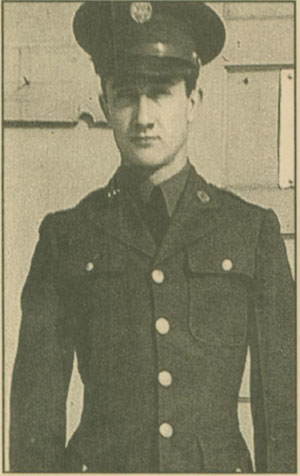
permission by Violet Canter

Remember...
Carey Kenneth Stockwell
1920-1941
"The patriot's blood is the seed of freedom's tree."
Thomas Campbell
 permission by Violet Canter |
Remember...Carey Kenneth Stockwell
|
Carey Kenneth Stockwell was born to John J. S. Stockwell and Sarah Ella Truman Stockwell (later Tanner) in 1921 in Clay County, West Virginia, and was the second youngest of the large Stockwell family. According to the 1920 and 1930 Federal Census records, as well as Ancestry.com, his siblings from oldest to youngest were Wilbur (or Wilburn), Sylvia, Vessie, Dessie, Gracie (married name: Canfield), Evie (or Eva), Clara, Nellie (married name: Hively), Audrey (or Audra), and Maycel, with Maycel being younger than Carey. His father was a farmer in Otter, West Virginia. Around the time Carey was born, West Virginia, specifically in Kanawha and surrounding counties, was experiencing a population boom as a result of the expanding coal industry. When Carey was just three years old, his father passed away and his mother was soon remarried to Enoch Tanner of Otter, West Virginia, who was a farmer, similar to John. Children of miners in this area would usually follow their fathers into the mines at a young age, doing dangerous work. As both of Carey's father figures were farmers, he avoided this fate.
During his teenage years, Carey experienced the deaths of his older sisters, Sylvia and Eva, adding to the loss of his father around a decade before. As both of Stockwell's father figures were farmers, it is most likely that he and his siblings were expected to help with work on the farm. This explains why Carey had no other jobs before his enlistment in the military, as he was spending his time working on the family farm. He attended school, where he learned to read and write, but he never used this knowledge in a career other than military service.
When he was 19, Carey enlisted in the United States Army. He served in the 42nd Bombardment Squadron, 11th Bombardment Group, 7th Air Force. Throughout the U.S. engagement in World War II, his squadron traveled between islands in the Pacific as part of the military strategy "island hopping" that was used in that era, but they were stationed at Hickam Field, Honolulu, Hawaii, from February 1940 until 1941 on the fateful date of the Pearl Harbor attacks. ("42nd Bombardment Squadron [Heavy], 1941-1946," Texas A & M University Special Collections, accessed 7 April 2017, http://oaktrust.library.tamu.edu/handle/1969.1/91130.)
The United States at the time of Carey's birth was experiencing a time of economic prosperity, known to many as the "Roaring Twenties." This period of economic stability, coupled with an expansion of mining and industry, contributed to the population boom that was happening in West Virginia at this time, and mirrored what was happening throughout the U.S. The 1920 United States Federal Census, the first census Carey was a part of, indicated a 15 percent increase in population since the 1910 census.
As tensions began to rise in Europe, the United States continued to embrace their policy of isolationism, which was enacted after World War I, in hopes of being able to remain neutral in the event of another world war. To support this, the Neutrality Acts of 1930 were passed to ensure that the United States was to remain out of war. After Germany's invasion of Poland, and World War II had begun, the United States passed the Reciprocal Trade Agreement Act, which was designed to allow the United States to provide aid to the Allied Powers without becoming involved directly in the war. Later, the Lend-Lease Acts and Atlantic Charter would also be passed to increase the amount of aid provided to Great Britain by the Americans. This method of indirect involvement lasted from 1939 until 1941, when the Japanese launched the attack on U.S naval base at Pearl Harbor. (Russ Barbour, 14 December 2016, "World War II," e-WV: The West Virginia Encyclopedia, accessed 6 April 2017, https://www.wvencyclopedia.org/articles/1353.)
Hickam Field was a major target as it housed many of the American aircrafts in the Pacific and was responsible for training many pilots. The Japanese wanted to incapacitate these planes and pilots to ensure that the United States could not immediately counter their attack. Almost 140 people died in the attack at Hickam Field and were honored with a bronze tablet that can be seen at the base today. ("History of Hickam Field, Joint Base Pearl Harbor-Hickam, Hawaii," 1 February 2013, 15th Wing, United States Air Force, accessed 6 April 2017, http://www.15wing.af.mil/Library/FactSheets/Display/tabid/1693/Article/376269/history-of-hickam-field-joint-base-pearl-harbor-hickam-hawaii.aspx.)
Private Carey Kenneth Stockwell was one of many of his squadron to lose his life in this attack. Those in the 42nd Bombardment Squadron that did survive the attack would go on to serve in the Battle of Midway, which was a critical turning point in the war. ("42nd Bombardment Squadron [Heavy], 1941-1946.") After this battle, the Japanese were weakened, allowing for the United States to have an advantage in the war.
Article prepared by Carly Stewart, George Washington High School Advanced Placement U.S. History
2017

West Virginia Archives and History welcomes any additional information that can be provided about these veterans, including photographs, family names, letters and other relevant personal history.